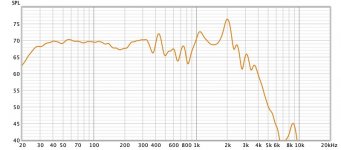Yes, but I can’t help myself 🙂, I am an ardent opponent of using a coil, glue, centering washer, diffuser and rubber rim at the bottom of the range, which certainly does not mate with the weightless electrostatic membrane and has an order of magnitude more distortion, especially at the bottom of the frequency range .Hi,
I admit to have difficulties to understand Your point.
I also agree on subwoofers in the way they are typically 'mated' with their satellite speakers.
Most subs I find are crossed over too high in frequency.
I disagree on Your general critique on Subs though.
Well executed a subwoofer improves the sound experience.
jauu
Calvin
Moreover, I believe that electrostatic should be used primarily at the bottom of the range, and in medium and high registers you can use ordinary high-quality speakers with magnets and coils for the same reasons - the greatest amount of distortion occurs precisely at the bottom of the frequency range, where electrostatic can win qualitatively a speaker with a magnet and a coil.
By the way, you can make such an experiment and tell here on the basis of it.
I would love to get a hornresp OB sim.
Hornresp can model OB. It does some things extraordinarily well but seems to assume the baffle is circular. It must be a horn thing.
So I modelled one Peerless 12" SLS-P830669 in a flat 35 x 35cm baffle on the floor. Then added extra of these baffles.
Hornresp is brilliant in modelling power and driver excursion. Below the bottom trace is two speakers and the top four. Doubling speakers from one to two gets you +6dB. So one extra woofer yields +6dB. The next bit is interesting. Doubling speakers from two to four gets you +6dB. So one woofer now just gives +3dB. Thats a waste.
So Id suggest doing just two per side if you dont listen at deafening and deaf inducing levels. Perhaps build two OB each with two drivers. Build them so you can run them as a stereo pair and also doubled up as a stack of four so you can measure and confirm.
The sim below was with power limited to 80W - the drivers take 110W but the sim shows you could quickly bottom out the drivers at low frequency. Even at 80W theres danger. Under 50Hz you need to really filter steeply. Id suggest a steep high pass at 40Hz too.
The baffle-driver dipole peak is at 500Hz with a -6dB slope down until Xmax=8.3mm hits. The drivers are meant to be good for 2000Hz. So the drivers should be good for at least 400Hz rather then 100Hz?
Id suggest with DSP trying them up to 300Hz and then backing down. I wouldnt be surprised if you like them doing up to 250Hz for the warmth and fullness of timbre that music needs to sound good.
In terms of bottom extension Xmax limits to 93dB at 40Hz with two drivers. If you listen to rock, jazz or classical that should be fine as bass levels usually drop off fast eg 20dB drop from 77Hz down to the 40Hz in the spectral analysis below where you can see 40Hz is the lowest fundamental - probably its the 41Hz bass lowest note.
So if you listen to acoustic not too loud, two 12" Peerless per side could work?
If you listen to electronic music you're in artificial territory and will need a sealed sub or two.
and below is how you could wreck the woofers with excessive excursion in an OB at 220W with no high pass filter.
Xmax is only 8.3mm and Pmax is 220W.
Last edited:
Automatic DSP room correction in a subwoofer also helps in this regard, since placement no longer has to be perfect to get the smoothest response.But it could be me making errors (placement, filters).
...out of memory I´d say::
- diam: 16-18cm
- fs ~35-40Hz
- Qts ~0.4-0.5
- Qes ~0.45-0.6
- Vas ~20-30L
- Xmax >4mm
OB 155cm x 20cm tower of nine 6" woofers: http://www.loudspeakerdatabase.com/Peerless/SDS-160F25PR01-08
Looks like a good match to a sealed sub under 80Hz and an ESL over say 300Hz?
Hi,
yes, going hybrid eases the audio transformer Q alot.
You could then use simple power toroids typically costing considerably less .... and more than once even giving better results and lifetime.
jauu
Calvin
yes, going hybrid eases the audio transformer Q alot.
You could then use simple power toroids typically costing considerably less .... and more than once even giving better results and lifetime.
jauu
Calvin
Hi,
"Moreover, I believe that electrostatic should be used primarily at the bottom of the range, and in medium and high registers you can use ordinary high-quality speakers with magnets and coils for the same reasons - the greatest amount of distortion occurs precisely at the bottom of the frequency range, where electrostatic can win qualitatively a speaker with a magnet and a coil."
A electrostatic panel performs only low in THD as long as the membrane excursion can be kept small ... less than 1mm after my experience. THD inevitably rises -rather almost 'explodes'- towards low frequencies, not least due to the acoustic short of the dipole requiring larger excursions than a monopole for same output.
Not accounted for the THD of the audio tranny, which could be even higher than the panel's.
The ESL reigns above ~200Hz, not below. That is dynamic driver's territory without any doubt.
And with every Hz You're striving to go lower than ~150Hz, You loose more than You could possibly win.
Quality of performance almost falls of the clips.
Modern dynamic bass drivers, especially when used in multiples/arrays outperform any ESL of practical size in almost any aspect, like THD, SPL max, amplitude linearity, 'precision', etc.
jauu
Calvin
"Moreover, I believe that electrostatic should be used primarily at the bottom of the range, and in medium and high registers you can use ordinary high-quality speakers with magnets and coils for the same reasons - the greatest amount of distortion occurs precisely at the bottom of the frequency range, where electrostatic can win qualitatively a speaker with a magnet and a coil."
A electrostatic panel performs only low in THD as long as the membrane excursion can be kept small ... less than 1mm after my experience. THD inevitably rises -rather almost 'explodes'- towards low frequencies, not least due to the acoustic short of the dipole requiring larger excursions than a monopole for same output.
Not accounted for the THD of the audio tranny, which could be even higher than the panel's.
The ESL reigns above ~200Hz, not below. That is dynamic driver's territory without any doubt.
And with every Hz You're striving to go lower than ~150Hz, You loose more than You could possibly win.
Quality of performance almost falls of the clips.
Modern dynamic bass drivers, especially when used in multiples/arrays outperform any ESL of practical size in almost any aspect, like THD, SPL max, amplitude linearity, 'precision', etc.
jauu
Calvin
It seems to me that it depends on the practical implementation. Here is a recording of 1000Hz, 500Hz, 100Hz and 30Hz signals from my subwoofer, the distance from it to the microphone is 3 meters (sofa, listening place), you need to listen with headphones: https://drive.google.com/file/d/1W5xTUCXMDEznRoIrBajNw9kWZCOzDTi0/view?usp=sharingHi,
"Moreover, I believe that electrostatic should be used primarily at the bottom of the range, and in medium and high registers you can use ordinary high-quality speakers with magnets and coils for the same reasons - the greatest amount of distortion occurs precisely at the bottom of the frequency range, where electrostatic can win qualitatively a speaker with a magnet and a coil."
A electrostatic panel performs only low in THD as long as the membrane excursion can be kept small ... less than 1mm after my experience. THD inevitably rises -rather almost 'explodes'- towards low frequencies, not least due to the acoustic short of the dipole requiring larger excursions than a monopole for same output.
Not accounted for the THD of the audio tranny, which could be even higher than the panel's.
The ESL reigns above ~200Hz, not below. That is dynamic driver's territory without any doubt.
And with every Hz You're striving to go lower than ~150Hz, You loose more than You could possibly win.
Quality of performance almost falls of the clips.
Modern dynamic bass drivers, especially when used in multiples/arrays outperform any ESL of practical size in almost any aspect, like THD, SPL max, amplitude linearity, 'precision', etc.
jauu
Calvin
Last edited:
I have to agree with Calvin here , electrostatics just don’t do low bass like sealed box woofers with a Q of .7 to maybe 1.0
tops. Inner sounds transmission line also is the best I have ever heard with an esl panel.
The standard low bass woofer is not the bad guy and is basically the best implementation to par with an esl.
You get a lower distortion esl with louder dynamic swings easily
The only exception would be if you have a very small room and don’t play loud and can’t blend a sub there.
tops. Inner sounds transmission line also is the best I have ever heard with an esl panel.
The standard low bass woofer is not the bad guy and is basically the best implementation to par with an esl.
You get a lower distortion esl with louder dynamic swings easily
The only exception would be if you have a very small room and don’t play loud and can’t blend a sub there.
recording of ........30Hz signals from my subwoofer,
@havun - Thanks for sharing your amazing ESL bass panel design.
What you are talking about with your ESL bass design is so radical no one can follow here. The language barrier doesn't help.
The reaction is likely to go something like: "An ESL subwoofer? An ESL subwoofer putting out 30Hz at 3m? Impossible!"
It might help if you link to your ESL thread or make a new youtube video of the ESL sub in action.
Here's the 30Hz spectrum. The second and third harmonics are low. Is the 50Hz a room node?
Room resonance is around 25Hz, while 50 and other peaks are more like harmonics and reflections.
@kazap: thanks a lot for your simulations and help! This is much appreciated.
Before your post I already finished 1 OB speaker consisting of 4 drivers, but I can easily split it in two sepearate speakers. I own a low power amplifier which I think is safe to experiment as your simulations show max. excursions are not too difficult to produce at lower frequencies.
I agree it is interesting to start crossing over at 300 Hz and then lower cross over frequency. First impression at 300 Hz when testing yesterday was that it sounded impressive! I didn't had much time, tomorrow I will have more time to do new measurements and experiments, so I will post my findings soon. But the quick impression is that as told by you and a few other members, music sounds more lively. But this was after a quick implementation of the cross over filter without much fine tuning and testing and comparing. I crossed over at 200 Hz as well and this seemed to sound a little bit better than 300 Hz. I used a high pass filter at 35 Hz @48 dB/oct as after doing some carefull measurements and tests it seemed the drivers were doing small excursions at testing sound volumes. But at one recording the stats sounded still a little bit better overall. But the quick conclusion is that this sounds promising, is easy to implement and seems like the best result after many years of trying different cone based woofers.
Before your post I already finished 1 OB speaker consisting of 4 drivers, but I can easily split it in two sepearate speakers. I own a low power amplifier which I think is safe to experiment as your simulations show max. excursions are not too difficult to produce at lower frequencies.
I agree it is interesting to start crossing over at 300 Hz and then lower cross over frequency. First impression at 300 Hz when testing yesterday was that it sounded impressive! I didn't had much time, tomorrow I will have more time to do new measurements and experiments, so I will post my findings soon. But the quick impression is that as told by you and a few other members, music sounds more lively. But this was after a quick implementation of the cross over filter without much fine tuning and testing and comparing. I crossed over at 200 Hz as well and this seemed to sound a little bit better than 300 Hz. I used a high pass filter at 35 Hz @48 dB/oct as after doing some carefull measurements and tests it seemed the drivers were doing small excursions at testing sound volumes. But at one recording the stats sounded still a little bit better overall. But the quick conclusion is that this sounds promising, is easy to implement and seems like the best result after many years of trying different cone based woofers.
Attachments
-
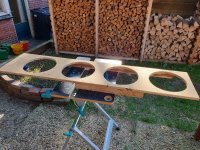 20220402_165451_copy_800x600.jpg227.2 KB · Views: 185
20220402_165451_copy_800x600.jpg227.2 KB · Views: 185 -
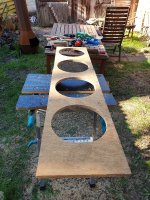 20220402_165504_copy_600x800.jpg230.8 KB · Views: 163
20220402_165504_copy_600x800.jpg230.8 KB · Views: 163 -
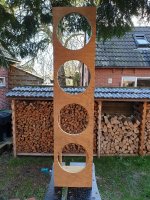 20220402_182156_copy_600x800.jpg243.6 KB · Views: 171
20220402_182156_copy_600x800.jpg243.6 KB · Views: 171 -
 20220403_113039_copy_600x800.jpg148 KB · Views: 175
20220403_113039_copy_600x800.jpg148 KB · Views: 175 -
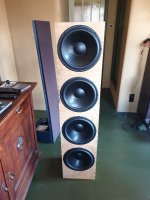 20220403_113057_copy_600x800.jpg114.9 KB · Views: 178
20220403_113057_copy_600x800.jpg114.9 KB · Views: 178 -
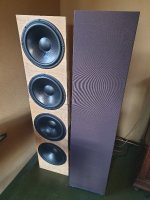 20220403_115444_copy_600x800.jpg139.7 KB · Views: 182
20220403_115444_copy_600x800.jpg139.7 KB · Views: 182
Last edited:
Fair point. The money one saves is good to spend for dynamic cone drivers for LF sound production 🙂Hi,
yes, going hybrid eases the audio transformer Q alot.
You could then use simple power toroids typically costing considerably less .... and more than once even giving better results and lifetime.
jauu
Calvin
When crossed over far away from fundamental panel resonance, I think I can omit the damping screens, which leads to even more transparent sound in my personal experience. Do you use any loudspeaker grilles or damping sreens for your esl panels? Because I think there is one important advantage of using them (besides damping resonances in mid frequency range): protecting the stats from dust particles which settle on the diaphragms.
Hi,
I don´t use any grill, cloth or film.
They are manstats ... the Chuck Norris of Stats ... they don´t care about dust ... dust takes care not to come close 😎
jauu
Calvin
I don´t use any grill, cloth or film.
They are manstats ... the Chuck Norris of Stats ... they don´t care about dust ... dust takes care not to come close 😎
jauu
Calvin
... I already finished 1 OB speaker
Nice work! The four driver tall OB matches the ESL so well it would be a pity to cut it in half.
In terms of positioning:
1. Can you try the OB side hard up against the a sidewall and a good distance from the front wall? Then angle the OB at the listening postion and in the same plane as the ESL. Listen and measure. Hornresp indicates the SPL will go up appreciably.
2. If you put the OB next to the ESL maybe try a reasonable gap eg 10cm-20cm so the ESL membrane isn't incorporated into the OB baffle pressure effect.
@kazap: I will try that soon and report back!
I did some listening tests and measurement last week but didn't manage to make it sound good enough to be satisfied: the sound had more punch in the bass, but when switching the same esl with and without OB woofer, using several different filters with x-overs of 150-300 Hz, the conclusion was that the extra puch welcome for some recordings and the best sounding of all previous non OB attempts. But mid-bass sound quality was audibly lower when using the OB woofer compared to my esl in "full range" (no OB woofer) mode. I used only the left channel for testing, with and without OB woofer.
So tonight I made some measurements again, starting from zero. I hope you can help me finding some posibble errors / mistakes I might have made.
My idea was to first put the mic very close to the woofer, 3 cms, and measure it's response without any filtering:

This seems similar in response to the simulation from Edge in the previous post. I decided to add two notch filters to take care of the peak at 300 Hz and the dip at 180 Hz:
first notch at 180Hz, 3dB, Q=4
second notch at 300 Hz, -3dB, Q=6
Result (mic still at 3 cm in front of woofer):

After that I decided to correct the -6 dB/oct dipole roll-off by adding two low shelving filters:
first low shelving filter at 100Hz, 7dB, Q=0.8
second low shelving filter at 200Hz, 7dB, Q=0.8

After that I measured again at 3cm distance:

this looks like a +6dB/oct slope starting at 300 Hz and stopping at 55 Hz. I added a high pass filter at (only) 35 Hz, 48dB/oct LR, to prevent too large excursions (I constantly check cone excursions but they never make large excursions during my tests using a low power amplifier):


After this measurement I put the microphone close to the sofa / listening position, about 4 meters awai from the woofer and measured again, first with all filters active:

I didn't expect the boost between 100 - 150 Hz. Is this due to an error / mistake? I made another measurement without all parametric equalizer filters, only the high pass filter, again at 4 meters:

So my first question is: did I made a mistake as the response at 4 meters looks very rough?
I did some listening tests and measurement last week but didn't manage to make it sound good enough to be satisfied: the sound had more punch in the bass, but when switching the same esl with and without OB woofer, using several different filters with x-overs of 150-300 Hz, the conclusion was that the extra puch welcome for some recordings and the best sounding of all previous non OB attempts. But mid-bass sound quality was audibly lower when using the OB woofer compared to my esl in "full range" (no OB woofer) mode. I used only the left channel for testing, with and without OB woofer.
So tonight I made some measurements again, starting from zero. I hope you can help me finding some posibble errors / mistakes I might have made.
My idea was to first put the mic very close to the woofer, 3 cms, and measure it's response without any filtering:
This seems similar in response to the simulation from Edge in the previous post. I decided to add two notch filters to take care of the peak at 300 Hz and the dip at 180 Hz:
first notch at 180Hz, 3dB, Q=4
second notch at 300 Hz, -3dB, Q=6
Result (mic still at 3 cm in front of woofer):
After that I decided to correct the -6 dB/oct dipole roll-off by adding two low shelving filters:
first low shelving filter at 100Hz, 7dB, Q=0.8
second low shelving filter at 200Hz, 7dB, Q=0.8
After that I measured again at 3cm distance:
this looks like a +6dB/oct slope starting at 300 Hz and stopping at 55 Hz. I added a high pass filter at (only) 35 Hz, 48dB/oct LR, to prevent too large excursions (I constantly check cone excursions but they never make large excursions during my tests using a low power amplifier):
After this measurement I put the microphone close to the sofa / listening position, about 4 meters awai from the woofer and measured again, first with all filters active:
I didn't expect the boost between 100 - 150 Hz. Is this due to an error / mistake? I made another measurement without all parametric equalizer filters, only the high pass filter, again at 4 meters:
So my first question is: did I made a mistake as the response at 4 meters looks very rough?
Attachments
switching the same esl with and without OB woofer, .... the best sounding of all previous non OB attempts. But mid-bass sound quality was audibly lower when using the OB woofer
I hope you are enjoying the DIY experiments. Thanks for sharing the journey. Well done with your progress. Thats great you have the best sound out of your 12" woofers so far with such a quick and simple OB, for low frequency ESL reinforcement.
Im no expert but while you waiting for smarter brains to chip in here are some ideas:
- You want to minimise the OB incursion into the midrange. A low pass steep filter on the OB looks needed?
- The unexpected boost at 100Hz may be room effects eg front and rear OB wave summation at 100Hz, followed by cancellation at 200Hz?
- Check out the Equal loudness contours which imply a tipped up lower end might be needed and help see what ESLs are up against in terms of power output down low. But you dont want the lows tipped up too far.
- measuring at 3cm in the extreme near field will be great for testing an individual woofer's integrity but wont say much about the baffle response
- measurements at the listening position itself has face validity, given the complex room interactions that for dipole bass include rear wave summation/interference effects
- time alignment between the OB and ESL may be important for listening quality. Do you have REW for doing a step ?
- the OB may need bracing at the top to prevent swaying blurring lower midrange output
- as mentioned its important to have the OB separated from the ESL. You dont want the ESL membrane to be part of the OB baffle and getting flapped around
- with your cross over to the ESL what might help is to maximise the ESL output and minimise the OB input - that would mean a very gradual upper crossover. The idea is the ESL will lead in timbre and timing. The OB can assist with SPL but this could be as little as possible. So a very gradual blend in of the OB.
- 12" woofer depending on the model may be better crossed over lower, compared to smaller woofers?
- Try measuring the single ESL output at and around the listening position at your normal and upper SPL's - multiple measurements in and near the head location will be interesting to uncover variance with small distance changes and allow averaging.
- Apply a high pass to the ESL to see if the mids sound better when unloaded from excessive bass excursions
- Then design the OB output to be time aligned and to fill in lower freq ESL SPL deficiencies
- Then listen while adjusting the OB upper crossover slope and reach until the ESL + OB sounds much better then the ESL alone
- The measure the combined Freq and Step responses and readjust for a nice freq slope and good time alignment
Last edited:
@kazap: thanks again for your extensive help and suggestions! I will try them soon. Yes I'm still enjoying the process of testing and measuring. I'm new to time alignment of drivers but I viewed the step responses of both esl panel and OB woofer and if I interpret them correctly, phase is right and I'm wondering if I should apply any delay at all? I made some screenshots again, mic positioned 0.5 meters from panel / woofer:
woofer frequency response without any equalizing:

woofer step response without any equalizing:

woofer frequency response with parametric equalizing to correct dipole peak and roll-off:

woofer step response with parametric equalizing to correct dipole peak and roll-off:

esl frequency response (without any equalizing):

esl step response:

Not sure if these measurements reaveal any problems?
As said, I still have to experiment with different cross over slopes, but yesterday I tried a simple x-over at 150 Hz, 48 dB/oct LR, high / low pass, but the extra punch the OB woofer adds is only audible in a few pieces of music for a short time. The mid bass is impaired by the OB woofer when compared to the esl in full range mode. Not by a big deal, but still clearly audible. I will try different filter configurations as suggested, but I get the impression that my stats perform quiete well, also in the lower frequency range. They still have a resonance peak at 60-70 Hz despite damping screens and loudspealer grille cloth, but at the moment I prefer the higher mid-bass quality of the esl in full range mode compared to the added puch of the OB woofer.
This leads me to the conclusion that these panels with their damping screens and big audio transformers and diaphragm / stator disance (1.5 mm) don't benefit from these OB woofers. Maybe it would be more interesting to build a new mid-high esl panel using smaller d/s distnaces like <= 1 mm and smaller (cheaper) transformers, having lower LF range but maybe more HF range / extension, and by crossing over at a higher frequency like 300 Hz, I can omit the damping screens which have an audible impairing effect on the sound quality. And I would be interested to build a OB woofer array using smaller drivers (6.5 - 8 inch) as, if I remember correctly, stated by Calvin, this sounded more pleasant compared to bigger drivers like I'm currently using. These smaller drivers give more options to cross over at higher frequencies.
woofer frequency response without any equalizing:
woofer step response without any equalizing:
woofer frequency response with parametric equalizing to correct dipole peak and roll-off:
woofer step response with parametric equalizing to correct dipole peak and roll-off:
esl frequency response (without any equalizing):
esl step response:
Not sure if these measurements reaveal any problems?
As said, I still have to experiment with different cross over slopes, but yesterday I tried a simple x-over at 150 Hz, 48 dB/oct LR, high / low pass, but the extra punch the OB woofer adds is only audible in a few pieces of music for a short time. The mid bass is impaired by the OB woofer when compared to the esl in full range mode. Not by a big deal, but still clearly audible. I will try different filter configurations as suggested, but I get the impression that my stats perform quiete well, also in the lower frequency range. They still have a resonance peak at 60-70 Hz despite damping screens and loudspealer grille cloth, but at the moment I prefer the higher mid-bass quality of the esl in full range mode compared to the added puch of the OB woofer.
This leads me to the conclusion that these panels with their damping screens and big audio transformers and diaphragm / stator disance (1.5 mm) don't benefit from these OB woofers. Maybe it would be more interesting to build a new mid-high esl panel using smaller d/s distnaces like <= 1 mm and smaller (cheaper) transformers, having lower LF range but maybe more HF range / extension, and by crossing over at a higher frequency like 300 Hz, I can omit the damping screens which have an audible impairing effect on the sound quality. And I would be interested to build a OB woofer array using smaller drivers (6.5 - 8 inch) as, if I remember correctly, stated by Calvin, this sounded more pleasant compared to bigger drivers like I'm currently using. These smaller drivers give more options to cross over at higher frequencies.
I'm not sure if this is related to your ESLs lack of care about dust, but you mentioned recently in another thread that your ESLs use a closely spaced double diaphragm triple stator configuration.I don´t use any grill, cloth or film. They are manstats ... the Chuck Norris of Stats ... they don´t care about dust ... dust takes care not to come close 😎
https://www.diyaudio.com/community/threads/electrostats-vs-conventional-drivers.17424/post-6986095
When experimenting with this configuration I noted 2 advantages besides the obvious ones of increased sensitivity and max SPL.
1) If you placed the coating on the diaphragm surfaces facing the middle stator, the diaphragms effectively become their own dust cover.
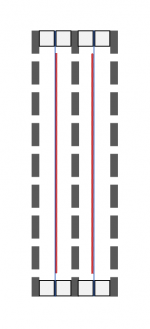
2) The step-up transformer wiring can be arranged such that both front and back stators are fixed at ground potential, removing any possibility of shock hazard.
https://www.diyaudio.com/community/threads/ground-reference-for-esls.205136/post-4052372
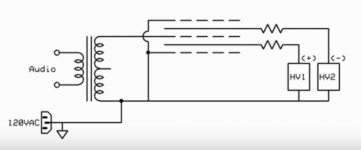
It makes absolutely no difference whether you place the conductive coating on the membrane, inside or out. The membrane is equally electrified from all sides, it is only a few microns thick. Where dust really collects and needs to be isolated there, it is the capacitors and diodes of the polarizing voltage multiplier on the membrane, because they are always in a static position. And the membrane does not stand still, but moves all the time, so it "shakes off" the dust. In 10 years of dealing with ESL, I have never noticed accumulation of dust on the membrane or stators, on the contrary, they are perfectly clean. Although dust settles on objects that are next to the speakers as usual. 😀When experimenting with this configuration I noted 2 advantages besides the obvious ones of increased sensitivity and max SPL.
1) If you placed the coating on the diaphragm surfaces facing the middle stator, the diaphragms effectively become their own dust cover.
View attachment 1043998
- Home
- Loudspeakers
- Planars & Exotics
- My newest pair of DIY electrostatic panels, advice needed
